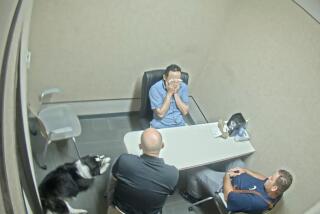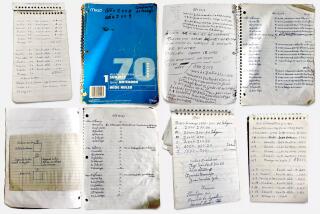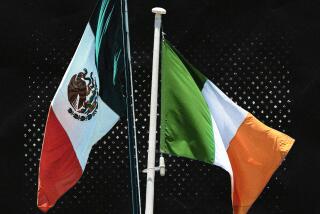The Many Deaths of a Rebel Priest
- Share via
Patrick Carney and his brother James became priests to help the poor, and both ran headlong into a wall of church conservatism. Patrick gave up and married. James embraced a controversial, radical doctrine as a missionary, earning the love of his peasant flock and the wrath of the Honduran army.
One day, during the dregs of America’s tropical Cold War, Father James Carney marched into the jungle with an ill-starred column of leftist guerrillas. The offensive ended quickly in captures and executions during a U.S.-aided Honduran army sweep in 1983.
That is the last trace Patrick, who lives in Los Angeles, has of his brother, though he and his five sisters have begged--and even sued--U.S. agencies to try to uncover his fate.
Finally, just before Halloween last year, the CIA sent the Carneys a declassified report, but it only opened a new Pandora’s box of ghoulish confusion:
Depending on the account, Honduran soldiers tortured and dismembered the 58-year-old priest. Or he died of starvation. Or a Honduran soldier tucked Carney’s skull into his knapsack--or maybe his entire head. Or he was thrown alive from a helicopter.
Most frustrating, the names of those who might know for sure--those who describe Carney’s body and the tortures and executions of his companions--are blacked out, turning potential leads into dead ends.
The Carneys are not the first American family to find themselves lost in a maze of denials and shrugs when U.S. officials are confronted by evidence that implicates their anti-Communist allies in the death of a U.S. citizen. The families of three American nuns and a lay worker raped and murdered in El Salvador heard Secretary of State Alexander Haig suggest that the women had run a roadblock and got themselves in trouble. The efforts of the family of Charles Horman to trace what became of him during the 1973 military coup in Chile were made into the movie “Missing.”
Patrick Carney is planning to appeal to Sens. Dianne Feinstein and Barbara Boxer of California for help. The Carneys would at least like to give James a Christian burial--if someone would only tell them where to find his remains.
The Carneys’ renewed effort comes at a time of criticism for a U.S. Cold War agenda that placed fighting leftist insurgency ahead of human rights in Latin America. Documentation is emerging of how U.S. officials downplayed or denied information on massacres of unarmed civilians, torture and executions--even murders of U.S. citizens--by anti-Communist military allies in hot spots such as Guatemala, Honduras, El Salvador and Chile.
“I think people in the Reagan administration know what happened to my brother. The Honduran army certainly knows,” said Patrick, 72. “Somebody in the CIA knows more than they’ve told us.”
Most Honduran officers involved in the 1983 sweep reportedly are still alive. And why was the Honduran army able to recover his brother’s wooden chalice, Bible and stole--but not his body?
Patrick and his sisters, all seniors, cannot wait much longer.
“Our brother should be properly buried in Honduras, where he was so loved,” said Virginia Carney Smith, 79, a mother of 12 and grandmother of 33 in Beverly Hills, Mich. “We’ll never stop searching. It has become a part of our lives.”
Dreams of Social Justice
James Francis Carney’s religious journey ended in a hushed, river-laced rain forest where toucans nest and jaguars roam.
It began in Depression-era Chicago and St. Louis, where his Irish Catholic father was a salesman. The Carney kids were steeped in the kind of religious fervor that moves children to identify with the Christian martyrs of 2,000 years ago. James was 17 months older than Patrick, but the youths were so close and looked so much alike that they were often confused.
So it was no surprise when, after the brothers’ World War II army stints and a St. Louis-to-Los Angeles hitchhiking lark, James enrolled at St. Stanislaus Seminary near St. Louis. Patrick followed. They were ordained together in 1961 and joined the Jesuits’ Latin American mission.
Along the way, their faith was tested: by white priests who were cool to black children; by bishops in Colombia whose cozy relationship with the aristocracy mocked the brothers’ dreams of social justice.
After Colombia, Patrick quit in disgust, but James became more determined to become an apostle of the poor.
When James was assigned to Honduras in 1964, he began a “complete metamorphosis of my whole mentality,” he wrote in his autobiography. Based in the northern town of Progreso, Carney adopted the name Padre Guadalupe, after Mexico’s virgin patroness. He drove from village to village, celebrating Mass and officiating at weddings and baptisms. He took up a machete and worked side by side with the dirt-poor peasants and even became a Honduran citizen to show he shared their fate. He said he was “trying to be like Jesus.”
In a 1997 editorial, Zulay Dominguez Chirinos, a Miami journalist from Honduras, recalled how children shouted with joy--”Father Guadalupe is coming!”--when the priest pulled up, how Carney treated the barefoot and penniless with respect and affection, how everyone loved him.
Not quite everyone.
Carney became deeply enmeshed in the region’s land reform battles, human rights issues and peasant organizations, and he became a follower of a Latin American church movement called Liberation Theology.
He began to speak out against U.S. support for a notoriously corrupt military government. Carney became convinced that “to be Christian is to be a revolutionary.” He told parishioners that it would be a privilege “if God would let me be killed . . . for the formation of his kingdom here.”
In November 1979, Carney was arrested, jailed, stripped of Honduran citizenship and deported to Miami.
U.S. authorities told Carney that his missionary status had kept his U.S. citizenship intact, his book said. The Jesuits reassigned him to Nicaragua, where a popular insurrection led by the leftist Sandinistas had toppled the brutal U.S.-backed Somoza dictatorship four months earlier.
There, Carney completed his transformation into a prophet of the left.
Patrick said that Honduras-based raids by CIA-backed Nicaraguan Contras further radicalized his brother. Though a lifelong pacifist and anti-Stalinist, Carney became a “Christian Marxist.”
“If they really want the liberation of the oppressed . . . some priests should enter into the armed struggle,” Carney wrote. His book, “To Be a Revolutionary,” was first published in Spanish a few months before his short-lived guerrilla odyssey.
Carney wrote that he was “not less a Christian, nor less a priest, by also being a revolutionary. To be killed for my following of Christ would be my greatest joy.”
The CIA report said Carney first tried to train with guerrillas in 1981, but was rejected because of his age. When the Revolutionary Party of Central American Workers-Honduras invited him to join, he reportedly wept with joy. Carney was to be an unarmed chaplain and spiritual advisor to the rebels, his family said.
Sometime in mid-July 1983, Carney left a Nicaraguan border village and crossed into Honduras’ Olancho province with 96 armed guerrillas. They were led by a former Honduran doctor, Jose Maria Reyes Mata, a onetime colleague of revolutionary leader Ernesto “Che” Guevara.
Chronicle of Doomed Mission
The mission seemed doomed from the start.
The Honduran army was on alert, the CIA report says, having learned of the rebels planning session in Mexico City that June.
The rebels hacked their way through dense jungle for nine days, pitching a base camp in mountains whose peaks exceed 9,000 feet. They were exhausted and undersupplied, with guns, ammunition and lots of cash but little food.
Carney tired quickly but was determined not to give up, relatives of captured rebels told the Carneys. Deserters said he became upset when Reyes Mata executed a rebel comrade and forbade Carney from holding Mass. Honduran officers say Carney got malaria.
When Honduran troops arrived, Carney was so weak he was being carried in relay shifts. The CIA report paints a sketchy and refracted picture of the demise of rebel column, but it is clear that the offensive was over quickly. None of the prisoners interviewed by one U.S. official had even seen combat, the report said.
On Aug. 26, a Honduran list of insurgents mentioned a possible priest named Guadalupe who was still at large. In mid-September, Hondurans mentioned a “Father Carney” who facilitated contacts with local peasants, the CIA report said.
On Sept. 19, the Honduran army told a news conference that a Padre Guadalupe had apparently died of starvation. Area newspapers detailed the story of the U.S. priest the next day.
On Sept. 21, the CIA report said, somebody--apparently a U.S. embassy official--concluded that “there was little likelihood that (Carney’s) body would be found.”
The Honduran military also reported that Reyes Mata died in a clash Sept. 18. U.S. officials began to suspect Reyes Mata had not died in combat because an army photo showed him in a uniform that seemed “surprisingly fresh and clean for someone who had been on the run in the jungle for weeks,” the CIA report said.
On Oct. 15, 1983, a U.S. cable reported that some guerrilla prisoners had been summarily executed,--including Reyes Mata and a few rebels already paraded before the news media, the report said.
The Honduran army “recognized that it would now face the threat of a disastrous international scandal for human rights violations,” the CIA report said. When the rebels’ bodies began to wash onto the banks of the Patuca River, the army disclaimed any knowledge.
Family Spoke to Field Commander
The Carneys rushed to Honduras. They said U.S. officials were cool to them, but did arrange for them to be flown to the Rio Patuca region to speak with a Honduran field commander, Leonel Luque.
“My sister begged him with tears in her eyes, ‘If you ever find out what happened to my brother, please help him, don’t let them kill him,’ ” Patrick recalled of his sister Eileen Connolly.
“The look in his eyes of shock and surprise was in sharp contrast with the way he had dealt with us up until that moment,” Patrick said.
U.S. officials concluded that Carney died of starvation or disease, and “questioning the Hondurans further would have indicated a lack of trust and not necessarily resulted in the truth,” the CIA report said. As the Carneys pressed the U.S. embassy, U.S. officials “indicated that exposure of the incident would focus sharp criticism on Tegucigalpa,” the report said. Tegucigalpa is the Honduran capital.
By April 1984, a U.S. defense intelligence analyst told the CIA, “the issue was forgotten at the embassy.” And between March 1985 and May 1995, the CIA review found no new U.S. investigations into Carney’s fate.
“The Fr. Carney case . . . is dead. We aren’t telling that to the family,” said a declassified 1985 U.S. embassy memo.
In February 1988, the Carneys filed a lawsuit in U.S. district court in Southern California, charging the U.S. government with violations of the Freedom of Information Act.
The CIA’s office of inspector general replied that the CIA “had no information indicating that Carney had been tortured or murdered.”
The CIA inspector general’s office initiated the new inquiry on Carney in 1995, after pressure from the Honduran human rights ombudsman and renewed U.S. media attention focused scrutiny on the CIA era in Honduras.
In June 1995, a letter from then-Rep. Robert Torricelli of New Jersey asked U.S. officials to respond to a report that Carney was interrogated in the presence of U.S. intelligence officers, then flown by helicopter over mountain wilderness and thrown out. A key source for the story was Florencio Caballero, a deserter from a CIA-trained military intelligence battalion responsible for numerous tortures and killings in Honduras, the Carneys said.
The CIA vehemently denied involvement in Carney’s death. But its reviews of old documents and new interviews began to tug at the curtain of secrecy shrouding the 1983 events.
An account quoted in the CIA report given to the Carneys says that then-Honduran military chief Gen. Gustavo Alvarez--a CIA intimate with a deplorable human rights record--declared that enough prisoners had been taken. And a commander in the field got an order to “search and destroy.”
Some of the Honduran officers executed 70 insurgents on the spot and “disappeared” 20 more, the source in the CIA report said. Reyes Mata was reportedly shot with a .45-caliber pistol.
The guerrillas had to “die in combat or be executed after we get information from them . . . in a place that can’t be found,” a commander is quoted as saying. “Each officer had to participate so they would not disclose their actions.”
In one scenario, Carney is killed with Reyes Mata.
But another version in the CIA report describes Honduran soldiers stumbling across Carney’s aide, who led the patrol to Carney, who was lying in a hammock, dead of natural causes. The soldiers supposedly recovered his priestly vestments but left his body, probably killing the aide, “as he was not needed,” the source said.
One shadowy story has a soldier placing Carney’s skull in his backpack; or carrying his head.
Another “indicated that Carney was tortured to death and dismembered by the Hondurans. Other scenarios . . . were that Carney had starved to death or was thrown from a helicopter. The Agency had not been able to establish or rule out any of these accounts,” a 1995 CIA update said. Today, the report said, “the precise fate of Carney remains unknown to the CIA.”
U.S. officials deny direct U.S. military involvement in the Honduran sweep but said U.S. helicopters did fly C-rations to the Honduran troops, the CIA report said.
Times reporter William Montalbano wrote in 1983 that U.S. Army helicopters also flew Honduran troops into the Rio Patuca region, “almost certainly a violation of congressional strictures against the presence of American troops in combat areas.”
Contras Cast Shadow on Case
Sources quoted in the CIA report suggest that U.S. officials did not aggressively seek information in 1983 because human rights issues were viewed as a thorn in the side of the most important policy initiative--the anti-Sandinista Contras.
Although recovery of Carney’s remains would have answered many questions, the Hondurans “were not inclined to recover the decomposing bodies of individuals who had threatened the security of their country,” a source told the CIA report. There is no evidence in the report that the United States pressured Honduras to produce the body.
One CIA expert responsible for preparing U.S. congressional testimony described “a politically charged atmosphere” in 1983, the CIA report said.
The expert “took great care in drafting congressional responses, as she did not want to take any action that could negatively affect covert-action funding. Congressional inquiries were interpreted and answered narrowly. She says there was never cause to believe that Carney had been executed,” the report said.
Another source said embassy officials “did not want information concerning human rights abuses during the Olancho Operation to be disseminated,” the CIA report said. This source believed embassy officials wanted reports “to be benign ‘so as to avoid Congress looking over its shoulders.’ ”
In this view, “reporting murders, executions and corruption . . . (would) not be beneficial in carrying out U.S. policy,” the CIA report said.
For another source, the “insurgents paid the price for their self-destructive behavior.”
Besides, “The focus at the time . . . was the Contras,” another source reportedly said.
Today, Honduran peasants still carry holy cards bearing pictures of Father Carney, who is one of 184 people who disappeared in Honduras in the 1980s.
“Padre Guadalupe’s is another striking story revealing the blood of the martyrs--or at least of the ‘disappeared’--as the seed of a church and society reborn,” wrote Robert McChesney, former director of the U.S. Jesuit overseas missions.
To the Carneys, he is also a brother, lost forever.
“I’m sure a lot of people know a lot of things,” Patrick said. “The truth matters so much to the people whose loved ones disappeared. They are thirsting for knowledge and justice. If we could find his body and build a shrine for those who venerate him, it would be a living legacy. But he lives on anyway, in the hearts of the people who loved him.”
More to Read
Sign up for Essential California
The most important California stories and recommendations in your inbox every morning.
You may occasionally receive promotional content from the Los Angeles Times.










